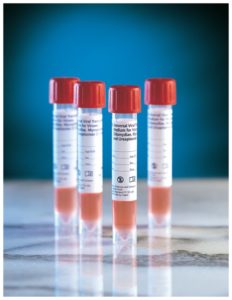Transport Medium used in Microbiology Laboratory (Viral & Bacterial)
Transport medium are special media formulated to preserve a specimen and minimize bacterial overgrowth from the time of collection to the time it is received at the laboratory to be processed. Depending on the type of organisms suspected in the sample, transport media may vary. However in general, transport media are classified on the basis of physical state as semi solid and liquid and also in basis of their utility as bacterial or viral transport media.
What does a transport media contain?
- Contains only buffers and salt.
- Doesn’t contain any nutritional ingredients such as carbon, nitrogen, and organic growth factors so as to prevent microbial multiplication.
- Addition of antibiotics and other substances like glycerol may be added for transporting specimens for tissue culture.
What samples are collected in transport medium?
All types of samples that may contain pathogens but could not be processed immediately requires transport medium. It may be Stool, urethral swabs, Nasal and throat swabs and specimens for tissue culture etc.
What are the commonly used Transport medium?
Given below are some examples transport medium with their purpose:
- Cary and Blair Medium: semi-solid, white colored transport medium for faeces that may contain Salmonella, Shigella, Vibrio or Campylobacter
- Amies medium with charcoal:Charcoal helps eliminate metabolic products of bacterial growth, which may be especially useful in the isolation of fastidious organisms like However it is suggested that, some other pathogens like Campylobacter can also survive in such medium.
- Amies medium without charcoal: Are ideal for the isolation of Mycoplasma and Ureaplasma
- Stuarts medium: Commonly used for transporting specimens suspected of having gonococci. Also used for transporting Throat, vaginal, wound and skin swabs that may contain fastidious organisms.
- Venkatraman Ramakrishnan (VR) medium: Used to transport feces from suspected cholera patients.
- Sach’s buffered glycerol saline: Used to transport feces from patients suspected to be suffering from bacillary dysentery.

- Viral Transport Medium : Viral Transport Medium (VTM) is ideal for diagnosis of viral infection. Ocular, respiratory and tissue swabs can be submitted in this medium. Fluid samples such as tracheal wash specimens or peritoneal fluid should be submitted as is, in sterile vials which prevent desiccation. In the absence of viral transport medium, submit swabs in sterile, sealed vials with several drops of saline added, to prevent desiccation. Cotton, plastic, wood-handled, and Dacron and other synthetic swabs are all acceptable. Calcium alginate swabs should be avoided. Bacterial transport medias are not appropriate for virology.
- Anaerobic Transport Medium (ATM): is a mineral salt base semi-solid media with reducing agents designed as a holding medium for maintaining viability of anaerobic bacteria It contains buffered mineral salts in a semi-solid media with sodium thioglycolate and cysteine added to provide a reduced environment. Resazurin may also be added as a redox indicator to reveal exposure to oxygen by turning pink. It provides an environment, which maintains viability of most microorganisms without significant multiplication and allows for dilution of inhibitors present in clinical material. Examples include thioglycolate broth